Laptop Mag Verdict
The BeagleBone is an easily customizable computer board for hobbyists and hardware hackers, but its performance could be better.
Pros
- +
Compact design
- +
Real-time programming through Cloud9 IDE
- +
Supports multiple operating systems
- +
Good educational tool
Cons
- -
Low processing power
- -
Lacks integrated Wi-Fi
- -
HDMI output costs extra
- -
Pricier than other DIY computers
Why you can trust Laptop Mag
The BeagleBone enters a market of low-priced, easily hackable computers. Similar to the Android 4.0 Mini PC and Raspberry Pi, the BeagleBone puts computing into the palm of the hand, making hacking and programming accessible and portable. This computer-on-a-board is slightly larger than a credit card, costs only $89 and is already powering larger devices on the market today. Does this device make computer programming and projects easily accessible?
Design
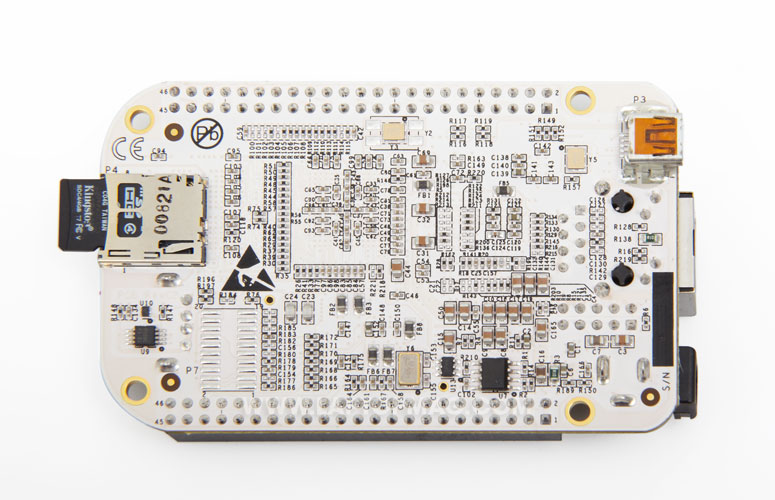
Click to EnlargeThe BeagleBone is an uncased computer that fits easily in the palm of your hand. Measuring 3.4 x 2.1 inches, the BeagleBone rivals the size of the 3.4 x 2.1-inch Raspberry Pi, a similar hackable computer board. The BeagleBone is slightly larger than a credit card and weighs only 1.3 ounces, virtually the same as the Raspberry Pi.
Ports include a 5V power input as well as Ethernet, microUSB, a microSD card reader and a 46-pin peripheral with multiplexed LCD signals and battery-control expansion headers. Unlike the Raspberry Pi Model B and the Android 4.0 Mini PC, the BeagleBone does not have a HDMI port, or any other video ports for that matter, relying on accessories to provide VGA or HDMI capabilities. So, you'll need to spend at least an additional $49 for the DVI-D addon that adds HDMI connectivity.
The BeagleBone does not include a case, exposing the hardware for the world to see. Hardware hackers and tinkerers have easy access to all the useful ports and pins and can quickly start customizing the device to suit their own specific needs and projects.
Setup
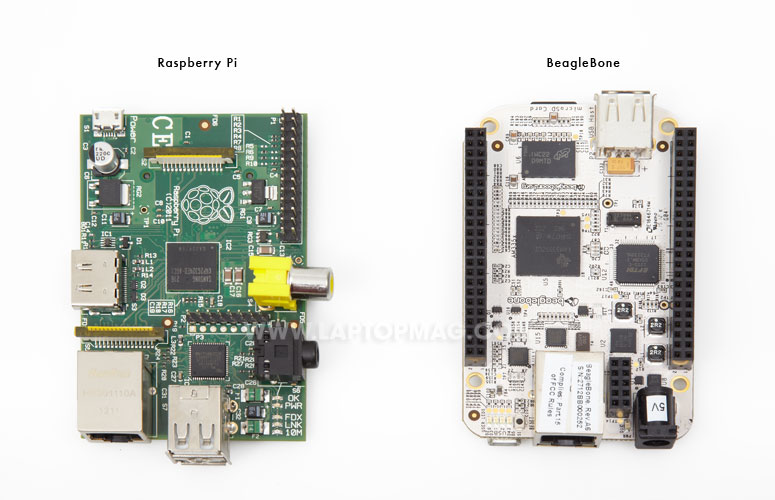
Click to EnlargeSetting up the BeagleBone is easier than the Raspberry Pi, since the BeagleBone comes with a 4GB microSD card preloaded with Angstrom Linux. Connecting the board to your computer will load the device as an external drive, where you'll be able to install the proper drivers and have instant access to the board through a Web browser (BeagleBoard recommends using Firefox or Chrome).
If Angstrom isn't your operating system of choice, others are available from BeagleBoard's website, including Android Gingerbread, Ubuntu, Debian and Fedora. To use one of these other operating systems, you'll need to flash the microSD card from your notebook or desktop computer. This process is more advanced than simple drag-and-drop, involving third-party tools such as Win32DiskImager for Windows and some command line prompts for the Mac and Linux.
Connecting the BeagleBone to your computer is only one way to interact with this device; accessing the Angstrom graphical user interface (GUI) requires a connected monitor.
Accessories
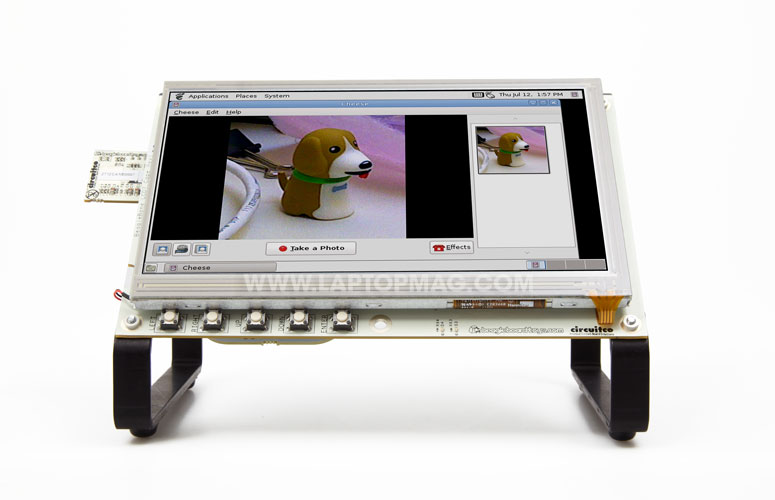
Click to EnlargeFor the budding hardware hobbyist or hacker, there is a wide range of accessories for the BeagleBone. Known as "Capes," a term inspired by the Underdog canine cartoon character, these accessories add functionality to the BeagleBone.
Rather than using the DVI-D Cape, we used the LCD7 Cape ($152), which has a 7-inch resistive touch-screen monitor with a built-in stand as well as a 3.1-MP camera Cape ($83) and a weather Cape ($72), which provides everything from the temperature to and biometric pressure to humidity.
These Capes are made and produced by individual users, rather than the BeagleBoard organization. These accessories usually start as an inspired hobbyist's successful experiment, who then produces more and sells them to other BeagleBone users.
Other accessories include a Battery Cape for $50, an Audio Cape for $55 and Capes that can assist hardware hackers by mapping out pins and ports. There are approximately 20 Capes available for the BeagleBone, and this number continues to grow as hardware tinkerers and distributors constantly build and create new add-ons.
Touch Screen
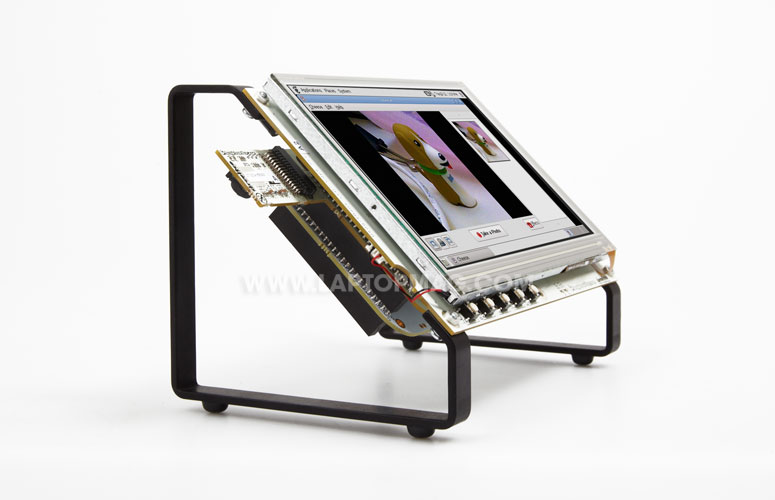
Click to EnlargeEven though the LCD7's touch screen worked with our fingers, tapping wasn't as accurate as most modern smartphones or tablets, degrading rapidly at the outer edges of the monitor. The included pen helped improve the accuracy and overall touch experience. The front of the LCD7 also has buttons for on-screen navigation: left, right, up, down and enter. When scrolling through a file folder or Web page, we opted to use these buttons for navigation rather than the window scroll bars, as it greatly improved our scrolling experience.
The on-screen touch keyboard was also difficult to use, so we quickly opted for an external keyboard connected to the BeagleBone's USB port. If you want to use a mouse in addition to the keyboard, you'll need a USB hub, since the BeagleBone has only one USB port.
Camera and Weather Capes
Click to EnlargeWe were able to take photographs successfully, using the webcam, but video recording repeatedly froze the Cheese webcam application. On our Cape, the camera was zoomed in by default and we couldn't figure out how to properly zoom out. We were informed that this isn't the usual case with the Camera Cape.
The weather Cape allows the user to measure temperature, barometric pressure, humidity and ambient light. Each of these factors can be accessed in real-time with Socket.io and JavaScript coding. The Angstrom Linux build includes a webapp called Weatherstation that allows you to immediately access the barometer and temperature gauge without writing any code. We measured the BeagleBone's temperature meter against our thermostat and the barometer reading against an online barometric pressure map, and both meters were completely accurate.
Cloud9 IDE
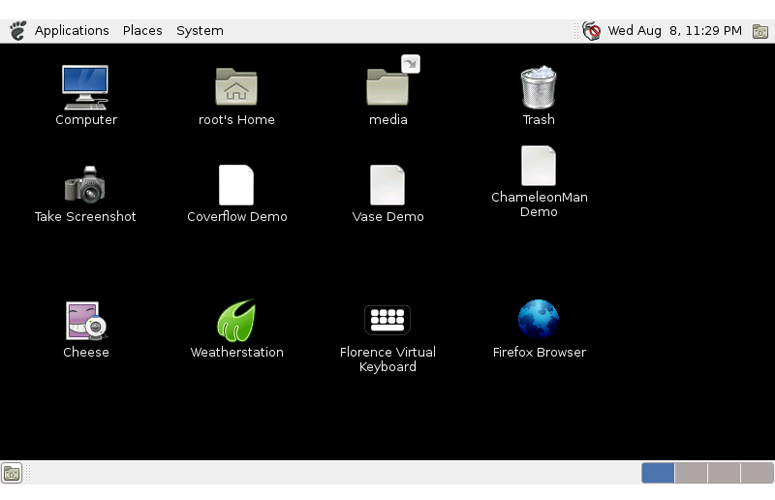
Click to EnlargeThere are numerous ways to interact with the BeagleBone. When connected via USB to a notebook or desktop computer, users can access the BeagleBone through a Web browser. This immediately launches a 20-slide presentation about interacting with the BeagleBone, including links to an integrated development environment (IDE), an SSH terminal, a JavaScript terminal and a bash shell.
Cloud9, the IDE that comes preinstalled on the BeagleBone, allows users to write applications directly in the browser without installing any additional software. Upon launch, users are able to take a guided tour, which shows how to navigate and how to use Cloud9 to program directly onto the BeagleBone. All sorts of tasks can be run through this real-time IDE, from turning an LED light on and off to controlling a robot attached through the 46-pin peripheral.
Performance
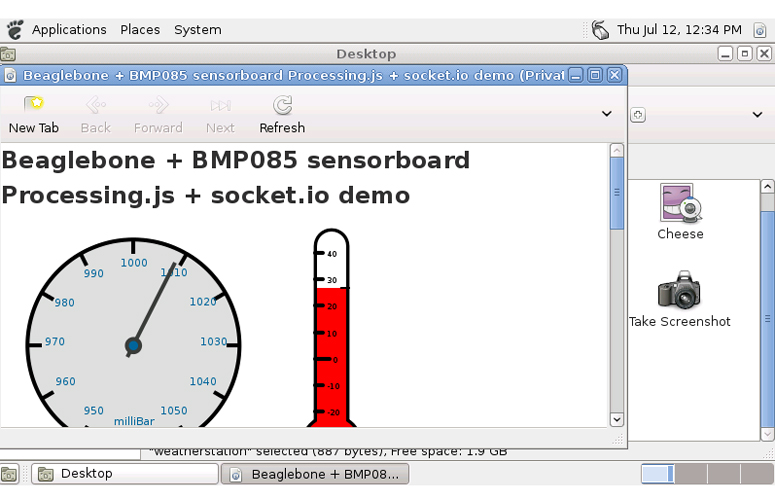
Click to EnlargeBeagleBone's 400-MHz TI AM3358 ARM Cortex-A8-based microprocessor and 256MB of RAM may be enough power to support larger projects, but it seriously drags when running a full operating system such as Angstrom. Forget gaming; you'll be waiting every time the BeagleBone has to load an application feature or function. Firefox loaded in 10 seconds, and opening new tabs or even clicking links will require some waiting, regardless of Internet speed.
When using Cheese, the application for recording photos and videos, we had to push the "capture" button numerous times before it registered our tap. Video recording was fruitless, as the application continually froze, requiring us to reboot the entire system without ever recording our video.
Startup time isn't any better. The BeagleBone took a whopping 2 minutes and 15 seconds to load the graphical user interface, compared with the Raspberry Pi's load time of 39 seconds.
Angstrom includes Xbox Media Center (XBMC), but the system was too slow to run the application properly and we weren't able to test video playback. The included browsers don't support Flash, either, so YouTube.com was unusable, and there are currently no good Flash plugins for Angstrom.
This does not mean this device is useless, even if media playback is your area of interest. Xbox Media Center can be flashed directly onto the memory card using a disk image available for download on the BeagleBoard website. When running within a separate operating system, XBMC is hindered since the BeagleBone must then run both the operating system and XBMC. All of the BeagleBone's resources are allocated to Xbox Media Center when another operating system isn't present.
Usage Scenarios
The BeagleBone is designed to do more than just run GUI-based operating systems. The power of the BeagleBone is when it controls other devices. With the proper programming and coding, the BeagleBone has powered 3D printers, industrial robotics, flying drones, Web servers and in-vehicle entertainment. BeagleBone is popular among hobbyists building larger projects and needing computer logic.
Popular Kickstarter Project Ninja Block is powered by a BeagleBone interior. Ninja Block uses if-this-then-that logic to connect the physical world to the computer using BeagleBone's Capes as sensors. Using an accelerometer and temperature sensor, the Ninja Block processes data and runs applications on the BeagleBone, reporting back to a Web application.
Verdict
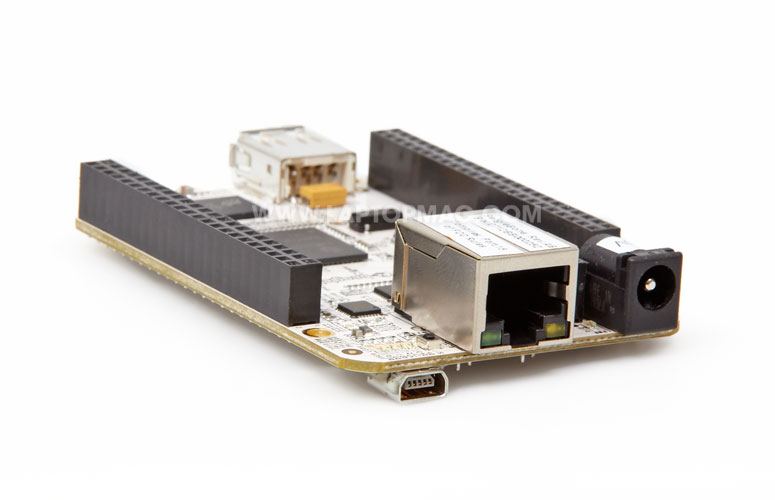
Click to EnlargeThe BeagleBone is a fun computer, making both software and hardware hacking easily accessible. Most functionality, however, comes from separate accessory "Capes," which provide features ranging from display connectivity to weather sensitivity. Running the Angstrum Linux build was too slow for real productivity, so the main purpose of this device is for education, hacking and as power for larger projects.
The Raspberry Pi Model B has similar features and only costs $35, but lacks the 46-pin peripheral that gives the BeagleBone an edge when it comes to connecting to other devices. If you're just starting your journey into inexpensive exposed-board computers, the BeagleBone may not be the best choice. But if you're working on a larger project, this computer is definitely worth a look.
BeagleBone Specs
| Company Website | http://www.beagleboard.org |
